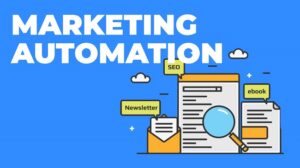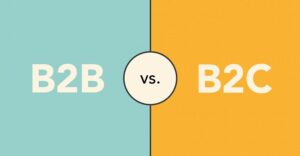I. What is Marketing Automation?
Marketing Automation involves using software to automate marketing processes such as segmenting customers, integrating customer data, nurturing customers based on pre-established scenarios, scaling operations, and improving brand engagement, conversion rates, and conversion value. It includes the ability to measure effectiveness for continuous improvement (planning, execution, measurement, and evaluation) of marketing campaigns.

II. Why should businesses use a Marketing Automation strategy?
1. Better reach and nurture potential customers
Using Marketing Automation software makes it easier to maintain and nurture potential customers without having to spend time connecting with each customer. Marketing Automation helps you focus your time on engaging with the right people on social media who are genuinely interested.
These platforms allow you to reach potential customers from the moment they start interacting with the business. All customer information such as name, phone number, email, and number of visits are stored in the data system to enhance customer interactions.
When customers message the business through the website or fanpage, they receive automated messages and are then transferred to the conversation window with customer service representatives.
2. Build relationships with customers
Relationship marketing involves understanding the needs of each individual customer and regularly updating them with information about products and services.

By using Marketing Automation platforms, businesses can personalize relationships with each customer through tailored programs and campaigns to maintain long-term relationships.
Marketing Automation help salespeople understand customer preferences and build rapport with them through automated content and emails. Instead of making scripted calls that may not be effective, data-driven marketing campaigns grab the customer’s attention more effectively.
3. Increase profits for the business
Investing in Marketing Automation requires a significant cost. However, when used effectively, the benefits far outweigh the investment.

Here are some statistics on the use of Marketing Automation platforms:
- A B2B marketing survey found that nurturing potential customers through Marketing Automation increases sales opportunities by 20%.
- Marketing Automation accounts for 33% of the marketing budget, according to Gartner’s CMO Spend Survey.
- 78% of marketers recognize Marketing Automation software as a key driver of increased profits for businesses.
- By 2020, 85% of customer relationships with businesses will be managed without human involvement, according to Gartner Customer 360 Summit.
4. Marketing Automation will tell you where to focus
Marketing Automation software can inform you who is likely to convert and when. There are two key sources of this information.
Knowing where visitors are on their buying journey and which call-to-action motivates them the most is the formula for success. Placing the most appealing call-to-action on the most viewed pages will yield high conversion rates from potential leads.
5. Shorten sales time and save costs for the business
Another benefit of Marketing Automation is that it saves time and costs for the business.
According to a 2016 report on Marketing Automation by SoftwareAdvice, businesses that use Marketing Automation platforms to nurture customers can increase actual potential customers by 451%.

Additionally, the system retains customer interaction history, allowing the sales team to focus on high-potential leads.
Marketing Automation is highly beneficial for businesses, supporting them in tracking customers from their initial awareness of your business. This makes it easier to monitor and segment customers based on potential levels.
6. Report ROI
Not only does it expand opportunities for generating revenue, but Marketing Automation is also an invaluable tool for reporting marketing performance.
Marketing Automation platforms allow users to assess the status and effectiveness of marketing channels in detail. Campaign performance reports are also quickly and systematically provided. This helps you make informed predictions and decisions to improve marketing effectiveness.
III. Marketing Automation in B2B and B2C
Businesses of all sizes can benefit from Marketing Automation. However, the way they use it depends on whether they are B2B or B2C.

Both types of businesses aim to improve conversions and revenue, but their approaches differ in achieving these goals. The comparison table below highlights the differences between how B2B and B2C companies implement Marketing Automation.

For B2B businesses looking to establish themselves as industry experts, providing premium information and expertise is a great way to achieve this.
In contrast, B2C businesses focus on building brand loyalty and giving customers reasons to return. Their messages often include:
- Abandoned cart reminders
- Personalized product recommendations
- Offers tailored to specific customer types.
VI. Marketing Automation process in digital marketing
A marketing process using Marketing Automation tools consists of the following steps:
Step 1: Marketing planning
In this step, you need to implement tasks such as identifying target customers, researching user behavior, determining the product to market, and setting pricing policies.
Step 2: Choose marketing automation tools
Today, there are many marketing methods to help you directly reach your target audience. Depending on the campaign goals and user habits, you can choose the appropriate marketing automation tools.
Step 3: Content planning
A Marketing campaign cannot lack content. To achieve the best results from automated marketing campaigns, you need to create engaging and attractive content.
Step 4: Implementation
Research keywords, update content, and execute marketing campaigns on social channels.
Step 5: Lead generation
When customers click on your link, the tool automatically collects their contact information and converts them into leads.
Step 6: Lead nurturing
Based on customers’ needs and habits, send suitable nurturing content.
Step 7: Closing sales
Quality leads are passed on to sales to close the deal.
Learn more: [4Ps of Marketing and effective marketing strategies for businesses]
V. Considerations for businesses when choosing to use Marketing Automation
1. Customer support policies
The level of support provided by your Marketing Automation platform provider is crucial, especially when it comes to promptly resolving technical issues. The complexity of Marketing Automation algorithms requires skilled professionals to address technical issues.
When researching Marketing Automation options, you should consider the provider’s support channels, such as ebooks, webinars, forums, etc. Alternatively, you can seek reviews of their support team. A good support team should respond to requests within 8 hours.

2. Free trials
Most Marketing Automation providers offer free trials of their services for periods of 7, 14, 30, or even 60 days. When trying the product, pay attention to how easy it is to use and whether the software meets your requirements and business capabilities. This will help you make an informed decision.
3. Pay attention to cost issues
In some cases, platforms may have hidden costs (e.g., additional fees for certain activities or support). Ideally, you should choose a platform with no hidden costs, but if you select one that may charge extra fees, it’s important to be aware of them upfront (and what causes them).

The reason this is important is that providers often charge based on the number of contacts in your database or the number of emails you send each month. So, if you have a large database but don’t plan to send daily emails, you may want to pay based on messages.
Conversely, if you have a small database but want to send three or four emails daily (not recommended), you might want to pay based on the size of your database.
4. Limitations
Some Marketing Automation platforms impose limits on the number of emails you can send or users you can have in the system (or charge extra fees if you exceed these limits). Just like with cost considerations, you should look for a platform that offers unlimited sending and user capacity to allow you to expand your customer base when needed.
5. Ease of use
When choosing Marketing Automation, evaluate the user-friendliness of the interface and the simplicity of its use. Research demo videos or request a trial to experience and evaluate it firsthand.
6. Reporting and analytics features
Explore how the Marketing Automation software analyzes data. How often are reports generated? How is data exported? Excel, CSS, or PDF? How is data filtered? Are you satisfied with it?
The entire system should be straightforward and easy to manage. The more complex a tool is, the harder it is to benefit from all its features. This is a challenge for Marketing Automation tool providers to enhance capabilities without sacrificing ease of use.
V. Conclusion
In this article, we’ve explained what Marketing Automation is. With the benefits that automation brings, it will undoubtedly become a strong trend and be widely adopted in the future.
One common misconception about Marketing Automation is that it primarily caters to B2B businesses and is essentially a scheduled email system (or even spam).
While many B2B businesses benefit from Marketing Automation, this success suggests that B2C businesses can also successfully apply Marketing Automation to their operations. This tool helps increase business efficiency and profitability.
Remember, before using Marketing Automation, ensure you have the time and resources to train on the software. 1Office hopes this article has provided you with valuable information about a powerful tool to solve your business’s marketing challenges. Good luck!
Additionally, if you’re struggling with business management and operational processes, consider 1Office software. This comprehensive ecosystem of management solutions will help you efficiently manage and optimize your business.







